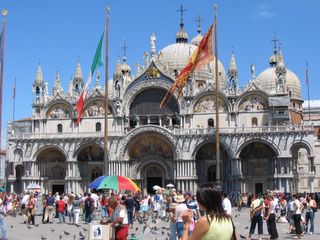Wednesday, July 13, 2005

Campanile di San Marco(St. Mark's Bell Tower): The 99m-tall Campanile di San Marco (St. Mark's Bell Tower) was built in the 9th century as lighthouse and tower to sight enemy fleets. Modifications were made in the 12th and 16th centuries and it the reached the present appearance in 1514 by Bartolomeo Bon.

St. Mark's in Venice, Italy consists of two magnificent structures: The Basilica and its sidekick, the Campanile. The Basilica is renowned for its medieval mosaics, its exquisite golden alter screens embellished with precious gems, and its gilded facade (see photo). A lavish amount of decorative gold was used on both the building's interior and exterior surfaces. This has earned St. Mark's Basilica its "Church of Gold" nickname. The present day church is the third to be erected on the plot. The original St. Mark's, a modest edifice, was built to house the stolen remains of the eponymous St. Mark.

The gondola is certainly the most photographed craft in the world and its image has become, for millions of tourists, the symbol itself of Venice. It is unique even for its building characteristics: it is asymmetric, as its left side is larger than the right one by 24 cm and so it always navigates inclined on one side. It has its bottom flat ; this allows it to cross even depth of few cm . For its construction they are used 8 different kinds of wood and it is composed of 280 pieces. The only elements in metal are the characteristic "iron" of the head and the " risso" of the stern.

A street in Venice: Venice is one of the exceptionaly beautiful cities in the world. Its beauty lies in its simplicity, not as glamarous as Paris and thus much more adorable.
The whole of the city is criss-crossed by a network of canals, and these are used as roads. Houses open directly into canals, and boats are parked like cars in front of the houses.

Colosseo (Colosseum (also spelt Coliseum)) known properly as the Flavian Amphitheatre, this most famous of Roman landmarks takes its name from the giant statue of the emperor Nero that once stood near this location. Originally capable of seating some 50,000 spectators for animal fights and gladiatorial combats, the amphitheatre was a project started by the Emperor Vespasian in 72 and completed by his son Domitian sometime in the 80s. The Colosseum when completed measured 48 m high, 188 m in length, and 156 m in width. The wooden arena floor was 86 m by 54 m, and covered by sand.

Fontana di Trevi: The fountain was built by the architect Salvi (1735) in the time of Clement XII, and decorated by several artists of Bernini's school. It is the front of a large palace (Palazzo Poli) decorated with statues and bas-reliefs on heaps of rocks.
The Fontana di Trevi is the 'Three Coins in the Fountain' fountain, the one that drenched Anita Ekberg in Federico Fellini's La Dolce Vita. Among those who are unaware that the "three coins' were thrown by three individuals, a current legend is reported that it is lucky to throw coins with one's right hand over one's right shoulder into the Trevi Fountain. Throwing one coin in will ensure that the thrower will return to Rome. Throwing two coins ensures that the thrower will fall in love with a beautiful Roman girl (or handsome boy), and throwing three coins now ensures that the thrower will marry that girl or boy in Rome.

Piazza del Popolo (popolo=people, but in this case Popolo derives from pioppo=poplar). At the center of the square the obelisk placed here by Domenico Fontana in 1589 as part of the urban plan of Sixtus V. It was originally erected in Heliopolis and it was brought to Rome and placed in the Circus Maximus by Augustus. It is dedicated to Rameses II and is topped by the mountains and the star of Sixtus V.

The Basilica of Saint Peter, officially known in Italian as the Basilica di San Pietro in Vaticano and colloquially called Saint Peter's Basilica, ranks second among the five major basilicas(The Latin word basilica (derived from Greek basiliké stoà, royal stoa), was originally used to describe a Roman public building, usually located at the centre of a Roman town. After the Roman Empire became officially Christian, the term came by extension to refer to a large, and important church that has been given special ceremonial rights by the Pope.) of Rome and its Vatican City enclave. Possibly the largest church in Christianity, it covers an area of 23,000 m² and has a capacity of over 60,000 people. One of the holiest sites of Christendom, it is believed to be the site of crucifixion and burial of the basilica namesake Saint Peter, one of the twelve apostles of Jesus and first Bishop of Antioch and later first Bishop of Rome. Tradition holds that his tomb is below the baldachino and altar; for this reason, many Popes, starting with the first ones, have been buried there. The current basilica was started in 1506 and was completed in 1626, and was built over the Constantinian basilica.
Contrary to popular belief, the basilica does not hold the distinction in the Roman Catholic Church of being the ecumenical motherchurch, as it is not the cathedral of the Pope (in fact, it is not a cathedral at all). That distinction belongs to the Basilica di San Giovanni in Laterano. However, due to the proximity of the Papal residence, most Papal ceremonies take place at St. Peter's. The basilica also holds a relic of the Cathedra Petri, the episcopal throne of the basilica's namesake when he led the Roman church, but which is no longer used. These are the sources of the confusion.

Directly to the east of the Basilica of Saint Peter is the elliptical St. Peter's Square (Piazza San Pietro), built between 1656 and 1667, in the center of which is a 25.5 m tall obelisk. The obelisk was moved to its present location in 1585 by order of Pope Sixtus V. The obelisk dates back to the 13th century BC in Egypt, and was moved to Rome in the 1st century to stand in Nero's Circus some 250 m away. Including the cross on top and the base the obelisk reaches 40 m. On top of the obelisk there used to be a large bronze globe allegedly containing the ashes of Julius Caesar, this was removed as the obelisk was erected in St. Peter's Square. There are also two fountains in the square, the south one by Maderno (1613) and the northern one by Bernini (1675).
Thursday, July 07, 2005

The Arc de Triomphe is a monument in Paris that stands in the centre of the Place de l'Étoile, at the western end of the Champs-Élysées. It is the linch-pin of the historic axis (L'Axe historique) leading from the courtyard of the Louvre Palace, a sequence of monuments and grand thoroughfares on a route leading out of Paris. Its iconographic program pitted heroically nude French youths against bearded Germanic warriors in chain-mail and set the tone for public monuments with triumphant nationalistic messages until World War I.

This large statue, made of dark diorite, portrays Amun protecting Tutankhamun. It was discovered in Karnak in 1857. The standing king, Amun's chief officiate in the temple, is wearing a feline pelt and faces in the same direction as his divine protector. Amun wears the traditional headdress featuring two tall vertical feathers, as well as the braided bead of the gods.

The Louvre Museum (Musée du Louvre) in Paris, France, is one of the largest and most famous museums in the world. The building, a former royal palace, lies in the centre of Paris, between the Seine river and the Rue de Rivoli. Its central courtyard, now occupied by the Louvre glass pyramid, lies in the axis of the Champs-Élysées, and thus forms the nucleus from which the Axe historique springs.

The Mona Lisa (Italian, Spanish: La Gioconda; French: La Joconde), less commonly rendered as the Monna Lisa, is an oil painting on poplar wood by the famous Italian Renaissance artist eonardo da Vinci. The painting shows a woman looking out at the viewer with what is often described as an "enigmatic smile". The title means "Madam Lisa". It stems from Vasari's identification of the sitter as the wife of Francesco del Giocondo, a wealthy Florentine businessman. Her name is known to have been Lisa. The alternative title La Gioconda is the feminine form of Giocondo. Coincidentally, in Italian giocondo means 'light-hearted' ('jocund' in English), so "gioconda" means "light hearted woman". Because of her smile, this version of the title plays on this double-meaning, as in the French "La Joconde". (Source: Wikipedia)

The Winged Victory of Samothrace, sculpted in 200 B.C in Greece, commemorates a naval victory in Rhodes. (Louvre) The Winged Victory of Samothrace, also called Nike of Samothrace, is a marble sculpture of the Greek goddess Nike (Victory), discovered in 1863 on the island of Samothrace (Greek: Σαμοθρακη, Samothraki) by the French consul and amateur archaeologist Charles Champoiseau.

The gate of Notre Dame cathedral in Paris. (Allegedly, the Portal of the Last Judgement)
In thinking of Gothic architecture, our thoughts always ascend. For that which embodies Gothic style most is lofty; Rose windows of stained glass, ornately crafted spires, and the guardians of grand cathedrals, the Gargoyles. Each is distinctly Gothic, and all distinctly Notre Dame de Paris.
Notre Dame de Paris was one of the first gothic cathedrals, and was built throughout the gothic period. Its sculptures and stained glass show the heavy influence of naturalism, giving them a warm human look that was lacking from earlier Romanesque designs.

The beautiful Ehekarussel (marriage roundabout) fountian. It is a fountain of a very different type, depicting the "bitter-sweetness of married life” on the basis of the verses of the cobbler poet Hans Sachs.
The cycle of man-woman relationship is all there, from courtship to marriage and beyond. Sex and love are prevalent at first, then slovenliness and physical abuse walk in, and the end is a horrific death. The joy is brief and on the surface, while the anger and hatred are as hard and cold as the bronze material. Here's the most melodramatic touch: interspaced among the various human emotions are pointed beak birds, prancing old goats, huge lizard heads, half-rotten carcass, and flowers in bloom. Not to mention a representation of Sachs waltzing! If Weber wanted to elicit shock with his work, he certainly succeeded.

Lorenzkirche (St. Lorenz Church) in Nuremberg. Begun in 1270, St Lorenz Kirche took more than 200 years to complete. An important part of the Nuremberg skyline, its twin spires flank the main west doorway. The doorways's sculptures depict the theme of redemption, from Adam and Eve through the Last Judgment.

































